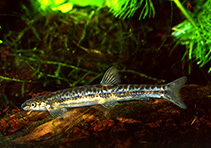| Diagnosis: |
Dorsal spines (total): -0; Dorsal soft rays (total): 10-11; Anal spines: -0; Anal soft rays: 8-9; Vertebrae: 43. Diagnosis: body relatively slender (Ref. 26644). Dorsal fin origin above or slightly before pelvic fin origin; body depth 6.5-9 times in SL; head length 4.5-5.9 times in SL (Ref. 26644, 89112). Head width 44.9-53.4% HL; snout length 37.7-49.4% HL (Ref. 26644). Pectoral fin length 4.9-6.1 times in SL (Ref. 26644, 89112). Pelvic fin 14.2-18.2% SL (Ref. 26644), with 9-10 rays (Ref. 26644, 89112). 98 to about 120 scales in lateral line (Ref. 26644, 89112). Caudal peduncle 1.8(juv.)-2.2 times longer than deep (Ref. 89112), 72.8-100% HL (Ref. 26644). Eye diameter 4.4(juv.)-5.5 times in HL, 1.7(juv.)-2.2 times in interorbital distance (Ref. 26644, 89112), 1.8-2.25 times in snout length (Ref. 89112). 13-16 pectoral fin rays (Ref. 26644, 89112). Color pattern with many small dark spots with an irregular edge on the back; if larger spots are present, they show light centers (Ref. 26644).
Description: snout not very flat, rather elongated, rounded; eye lateral, hardly visible from below (Ref. 89112). Mouth inferior, transversal (Ref. 26644, 89112), a narrow slit across the whole ventral surface, consisting of 2 arched parts (Ref. 26644). Lips with cutting edge (Ref. 89112). Maxillary bones forming small and short, proeminent, lateral pads (Ref. 89112) / narrow but well developed lappet at each end of ventral slit (Ref. 26644). Lower lip absent; lower jaw with cutting edge and medial notch, crenated, without adhesive possibilities; upper lip small, overhanging the cutting edge; pectoral fins long and rounded; caudal fin lobes more or less pointed; scales very small (Ref. 89112). Osteological details of gill arches and skull can be found in Ref. 89095.
Coloration: life: very variable; ground color of body olive on back, turning to golden on flanks and yellowish to whitish on belly; about 8 elongated dark olive-greyish spots along midside, in most cases not clearly defined, merging into each other especially behind dorsal fin to caudal peduncle; sometimes indistinct spots forming a dark midlateral stripe; numerous dark spots of same color and of very variable size and shape on back; large number of small spots in some specimens, in other these spots larger, extending from one side of the body across the back to the other side; smaller spots may be seen under the spotted midlateral line as well, in few fish no spots below this line; most specimens with 4 dark spots on caudal fin: 2 at base of each lobe and 2 near to the tip; dorsal, anal, pectoral and pelvic fins may show a very weak and indistinct dark band across middle of fin; iris of eye golden to silvery (Ref. 26644). Alcohol preserved: similar to live pattern; olive to golden ground color becomes light greyish, whitish on belly; dark pigmented spots dark grey to brownish (Ref. 26644). Body more or less covered by darker small spots or marbling transversally along the back; a series of more or less confluent, vagely defined, elongated spots along midlateral line; last midlateral spot on caudal fin base; caudal fin lobes with a small, round spot at the base and 2 vague, transversal bands in the middle (Ref. 89112). |
